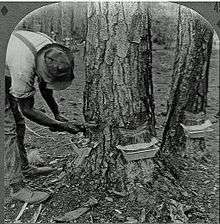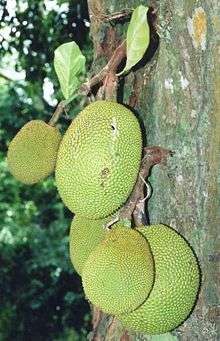Turpentine

Turpentine (also called spirit of turpentine, oil of turpentine, wood turpentine and colloquially turps[1]) is a fluid obtained by the distillation of resin obtained from live trees, mainly pines. It is mainly used as a solvent and as a source of materials for organic synthesis.
Turpentine is composed of terpenes, mainly the monoterpenes alpha-pinene and beta-pinene with lesser amounts of carene, camphene, dipentene, and terpinolene.[2]
The word turpentine derives (via French and Latin) from the Greek word τερεβινθίνη terebinthine, the name of a species of tree, the terebinth tree.[3] Mineral turpentine or other petroleum distillates are used to replace turpentine, but they are very different chemically.[4]
Source trees



One of the earliest sources was the terebinth or turpentine tree (Pistacia terebinthus), a Mediterranean tree related to the pistachio. Important pines for turpentine production include: maritime pine (Pinus pinaster), Aleppo pine (Pinus halepensis), Masson's pine (Pinus massoniana), Sumatran pine (Pinus merkusii), longleaf pine (Pinus palustris), loblolly pine (Pinus taeda) and ponderosa pine (Pinus ponderosa).
Canada balsam, also called Canada turpentine or balsam of fir, is a turpentine which is made from the oleoresin of the balsam fir. Venice turpentine is produced from the western larch Larix occidentalis.
In order to tap into the sap producing layers of the tree, turpentiners used a combination of hacks to remove the pine bark. Once debarked, pine trees secrete oleoresin onto the surface of the wound as a protective measure to seal the opening, resist exposure to micro-organisms and insects and prevent vital sap loss. Turpentiners wounded trees in V-shaped streaks down the length of the trunks so as to channel the oleoresin into containers. It was then collected and processed into spirits of turpentine. Oleoresin yield may be increased by as much as 40% by applying paraquat herbicides to the exposed wood.[5]
The V-shaped cuts are called "catfaces" for their resemblance to a cat’s whiskers. These marks on a pine tree signify it was used to collect resin for turpentine production.[6]
Converting oleoresin to turpentine
Crude oleoresin collected from wounded trees may be evaporated by steam distillation in a copper still. Molten rosin remains in the still bottoms after turpentine has been evaporated and recovered from a condenser.[5] Turpentine may alternatively be condensed from destructive distillation of pine wood.[2]
Oleoresin may also be extracted from shredded pine stumps, roots, and slash using the light end of the heavy naphtha fraction (boiling between 90 and 115 °C or 195 and 240 °F) from a crude oil refinery. Multi-stage counter-current extraction is commonly used so fresh naphtha first contacts wood leached in previous stages and naphtha laden with turpentine from previous stages contacts fresh wood before vacuum distillation to recover naphtha from the turpentine. Leached wood is steamed for additional naphtha recovery prior to burning for energy recovery.[7]
When producing chemical wood pulp from pines or other coniferous trees, sulfate turpentine may be condensed from the gas generated in Kraft process pulp digesters. The average yield of crude sulfate turpentine is 5–10 kg/t pulp.[8] Unless burned at the mill for energy production, sulfate turpentine may require additional treatment measures to remove traces of sulfur compounds.[9]
Industrial and other end uses
Solvent
The two primary uses of turpentine in industry are as a solvent and as a source of materials for organic synthesis. As a solvent, turpentine is used for thinning oil-based paints, for producing varnishes, and as a raw material for the chemical industry. Its industrial use as a solvent in industrialized nations has largely been replaced by the much cheaper turpentine substitutes distilled from crude oil. Turpentine has long been used as a solvent, mixed with beeswax or with carnauba wax, to make fine furniture wax for use as a protective coating over oiled wood finishes (e.g., tung oil).
Source of organic compounds
Turpentine is also used as a source of raw materials in the synthesis of fragrant chemical compounds. Commercially used camphor, linalool, alpha-terpineol, and geraniol are all usually produced from alpha-pinene and beta-pinene, which are two of the chief chemical components of turpentine. These pinenes are separated and purified by distillation. The mixture of diterpenes and triterpenes that is left as residue after turpentine distillation is sold as rosin.
Medicinal elixir
Turpentine and petroleum distillates such as coal oil and kerosene have been used medicinally since ancient times, as topical and sometimes internal home remedies. Topically it has been used for abrasions and wounds, as a treatment for lice, and when mixed with animal fat it has been used as a chest rub, or inhaler for nasal and throat ailments. Many modern chest rubs, such as the Vicks variety, still contain turpentine in their formulations.
Taken internally it was used as treatment for intestinal parasites, and candida because of its antiseptic and diuretic properties. A general cure-all.[10][11] Sugar, molasses or honey were sometimes used to mask the taste, and bait parasites.
Turpentine was a common medicine among seamen during the Age of Discovery. It is one of several products carried aboard Ferdinand Magellan's fleet in his first circumnavigation of the globe,[12] and is still used today as an alternative medicine.
Niche uses
Turpentine is also added to many cleaning and sanitary products due to its antiseptic properties and its "clean scent" In early 19th-century America, turpentine was sometimes burned in lamps as a cheap alternative to whale oil. It was most commonly used for outdoor lighting, due to its strong odour.[13] A blend of ethanol and turpentine added as an illuminant called burning fluid was also important for several decades. In 1946, Soichiro Honda used turpentine as a fuel for the first Honda motorcycles as gasoline was almost totally unavailable in Japan following World War II.[14]
Turpentine was a common additive in cheap gin until the 20th century and gave it its characteristic juniper berry flavour without the need for pricier distillations with aromatic spices and berries.[15]
Hazards
| NFPA 704 "fire diamond" |
|---|
As an organic solvent, its vapour can irritate the skin and eyes, damage the lungs and respiratory system, as well as the central nervous system when inhaled, and cause renal failure when ingested, among other things. Being combustible, it also poses a fire hazard. Because turpentine can cause spasms of the airways particularly in people with asthma and whooping cough, it can contribute to a worsening of breathing issues in persons with these diseases if inhaled.
People can be exposed to turpentine in the workplace by breathing it in, skin absorption, swallowing it, and eye contact. The Occupational Safety and Health Administration (OSHA) has set the legal limit (permissible exposure limit) for turpentine exposure in the workplace as 100 ppm (560 mg/m3) over an 8-hour workday. The National Institute for Occupational Safety and Health (NIOSH) has set a recommended exposure limit (REL) of 100 ppm (560 mg/m3) over an 8-hour workday. At levels of 800 ppm, turpentine is immediately dangerous to life and health.[16]
See also
- Charles Herty
- Galipot
- Naval stores industry
- Patent medicine
- Retsina
- Russia leather, a water-resistant leather, using a birch oil distillate similar to turpentine in its manufacture.
Sources
- Kent, James A. Riegel's Handbook of Industrial Chemistry (Eighth Edition) Van Nostrand Reinhold Company (1983) ISBN 0-442-20164-8
References
- ↑ Mayer, Ralph (1991). The Artist's Handbook of Materials and Techniques (Fifth ed.). New York: Viking. p. 404. ISBN 0-670-83701-6.
- 1 2 Kent p.569
- ↑ Barnhart, R.K. (1995). The Barnhart Concise Dictionary of Etymology. New York: Harper Collins. ISBN 0-06-270084-7.
- ↑ Dieter Stoye "Solvents" in Ullmann's Encyclopedia of Industrial Chemistry, 2002, Wiley-VCH, Wienheim. doi:10.1002/14356007.a24_437
- 1 2 Kent p.571
- ↑ Prizer, Tom (June 11, 2010). "Catfaces: Totems of Georgia's Turpentiners | Daily Yonder | Keep It Rural". dailyyonder.com. Retrieved June 5, 2012.
- ↑ Kent pp.571&572
- ↑ Stenius, Per, ed. (2000). "2". Forest Products Chemistry. Papermaking Science and Technology. 3. Finland. pp. 73–76. ISBN 952-5216-03-9.
- ↑ Kent p.572
- ↑ "Rural Life in the United States: Home Remedies". American Memory Timeline. The Library of Congress. 2002. Retrieved 2008-02-22.
- ↑ Delbert Trew (15 June 2007). "Coal Oil was Useful All-Purpose Home Remedy". Texas Escapes. Blueprints For Travel, LLC. Retrieved 2008-02-22.
- ↑ Laurence Bergreen (2003). "Over the edge of the world : Magellan's terrifying circumnavigation of the globe". ISBN 0066211735. Retrieved 2009-09-14.
- ↑ Charles H. Haswell. "Reminiscences of New York By an Octogenarian (1816 - 1860)".
- ↑ "Honda History". Smokeriders.com.
- ↑ Patrick Dillon (2002-06-01). "Distil my beating heart". The Guardian. London.
- ↑ "CDC - NIOSH Pocket Guide to Chemical Hazards - Turpentine". www.cdc.gov. Retrieved 2015-11-27.
External links
| Wikimedia Commons has media related to Turpentine. |
| Wikisource has the text of the 1879 American Cyclopædia article Turpentine. |
- Inchem.org, IPCS INCHEM Turpentine classification, hazard, and property table.
- CDC - NIOSH Pocket Guide to Chemical Hazards - Turpentine
- FAO.org, Gum naval stores: Turpentine and rosin from pine resin
- FloridaMemory.com, Florida State Archive photographs of turpentine camps and laborers
- HCHSonline.org, Timber and Turpentine Industries
- Distil my beating heart
- Florida's "Turpmtine" Camps
- Turpentine Industry at A History of Central Florida Podcast

